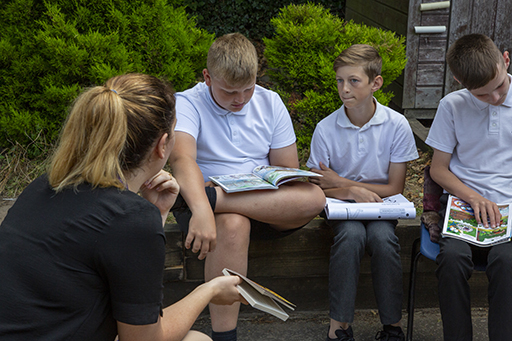9 Reader networks and relationships
When books become part of the social interaction in the classroom, they play a key role in connecting readers and can serve to establish small networks of readers. Some networks will be transient, for example four readers who have all recently read the latest Malorie Blackman or Jon Klassen book after signing up to read it on a Book Buzz chart and who were invited to chat to each other about it. Other networks may be more sustained, for example a group of children who regularly choose to sit together during reading time to discuss what they are reading, passing on books to one another over time and creating an in-group of readers. Tracking the library borrowing of young readers, Moss and MacDonald (2004) revealed considerable book traffic between small networks of readers. These might be hidden to a busy teacher’s eye, but they indicate the social support and interaction that engaged readers seek to sustain them.

As part of these networks, an interchange of ideas and views will develop between readers. This is not only healthy but to be encouraged, since by sharing their different views children will enrich their own understandings. This fosters reciprocal Reading for Pleasure and involves the cross-fertilisation of ideas, the development of new perspectives and the re-negotiation of previous ones. These processes are most effectively nurtured in open trusting contexts where all readers’ views are recognised, valued and discussed, on or offline. It is not limited to only young readers either, as adult readers also engage in casual conversations and debates about reading and many participate in book clubs or reading groups, sharing the pleasure of literary reading and drawing on their own life experiences to do so.
Personal reflection 3
Think about an occasion when you have been involved in discussing a text. You may have disagreed with others’ views, but perhaps come to appreciate their perspective.
- What was the text involved? A newspaper, recipe, a magazine article, a travel website, a novel?
- Did the discussion help you recognise the particular journalistic stance, understand more about how to cook the meal, or reveal more about a character?
- Was there a sense of pleasurable engagement in broadening your perspective and having others value your views?
Comment
In the discussion you recalled, you will have brought your own views and thoughts to bear. In the same way, it is important to enable children to bring something of their own reading selves, their views and perspectives to the classroom. This means hearing and valuing their voices and avoiding a sense of the ‘right answer’. When children share their thoughts, personal resonances and reading journeys with their peers and teachers, they share something of their lives and values. This openness helps to build connections and new reader relationships which offer a strong social motivation for reading (Cremin et al., 2014).
In order to nurture a love of reading, schools can work to foster such reader relationships and child-initiated networks. Some schools pair up older and younger readers to read and discuss books together regularly, as peer involvement can be motivational and lead to peer-assisted learning (Topping et al., 2016). Other schools invite teaching assistants to work with small groups of reluctant readers and identify texts that tempt and stimulate their curiosity. This helps to to maximise interaction and interest in each other’s views.
As well as networks of just young readers, adult–child reading schemes can also be beneficial. For example, one school in the UK has a Reading Buddies scheme in which staff members (teachers, teaching assistants, office staff) partner with ‘vulnerable’ readers and meet them once or twice a week for 5–10 minutes with a focus on sharing stories, poetry, jokes, magazines and so on. The adult reading buddy shows interest in the child as a reader, shares their own reading life, and develops reader-to-reader connections to support the reader. Such adult–child reciprocal relationships nurture and help sustain children’s engagement as readers and foster positive reader identities.

Optional resource
Case study: Developing whole school reading relationships at Jon Biddle’s school [Tip: hold Ctrl and click a link to open it in a new tab. (Hide tip)]
